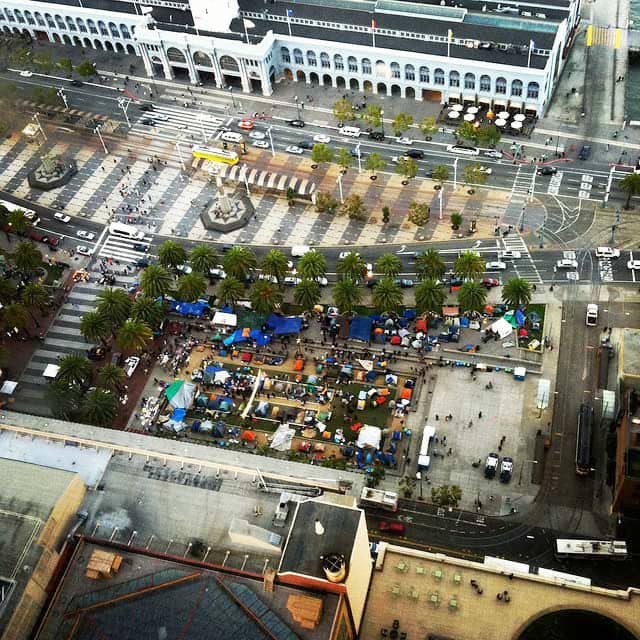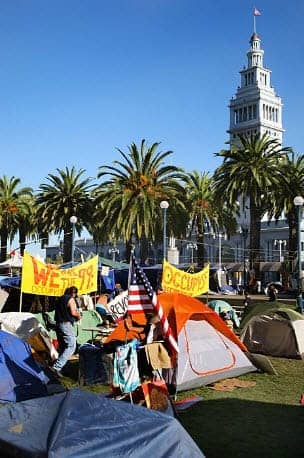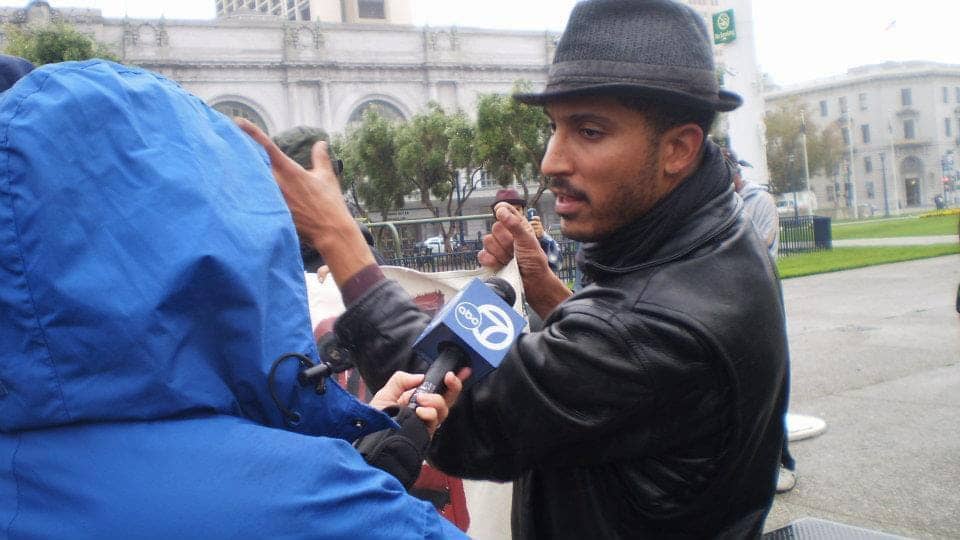I know I will be attacked by some for being "divisive" again, but come on folks, what do you not get.
 |
| The one white guy without a racist bone in his body |
Part of the struggle against white supremacy and racism, a major part, the major part, has to do with confronting it, especially amongst whites. A broad based populist movement like Occupy is full of folks from all over the spectrum, and as such there must be people within it and without it who are willing to confront the racism that comes along with the 99%.
Again, because I know how this will be taken, the vast majority of folks at Occupy sites are not overtly conscious racists. No one says they are. Again, many Occupy sites have individuals and groups within working on this problem. No one says they don't. Again, the criticism is offered by people not bent on destroying "your" movement.
I can't think of a majority white movement of any kind at any time to which this does not or has not applied.
Anyway, read the article below and weep...and then get mad...and then deal with it...and, please, understand where this all comes from and instead of attacking those who try to inform you about it, attack white supremacy and racism.
My mind is pre-occupied with racism in ‘Occupy’
“Please go online and get me money from Oprah. Tell her it’s so she (self-referential) don’t get killed on the streets of San Francisco.” – Mrs. Bowie
Posted By Mary On November 4, 2011 @ 11:34 am In SF Bay Area | 2 Comments

San Francisco Chronicle architecture critic John King wrote on Oct. 31 that “the Occupy SF village is enlivening the long dormant and depressing Harry Bridges Park – the 10-year-old strip of grass between the Hotel Vitale and Justin Herman Plaza that doesn't get used much by anyone except the homeless.” This photo was taken from 37 floors up. – Photo: Steve Rhodes
In my capacity as a local housing justice advocate and police accountability community worker, I have taken to visiting the encampment at Justin Herman Plaza to observe the conditions of life there and more specifically keep tabs on the interactions that the Occupiers have with various enforcement agencies. On the evening of Thursday, Oct. 27, I arrived to the south end of the camp with an activist videographer around 9 p.m. after leaving the Bayview Hunters Point Violence Prevention Summit.
Upon our arrival, the videographer and I observed two police cars parked in the south lot adjacent to the camp. Channel 7 News had a van in the same lot parked a little to the east of the cops and was setting up for a broadcast. By and large the scene was calm with various small groups of Occupiers scattered conversing, eating, smoking – in short, occupying.
No one out of the roughly 90 people present – 99 percent young and white – seemed to notice what to me was an obvious discrepancy from the rather placid scene, that of Mrs. Bowie sobbing amidst her completely broken down tent and disarrayed personal belongings. Alarmed, I approached her and inquired as to what happened. Her story was shocking.
“My head hit the cement right there,” Mrs. Bowie said, pointing out a spot just east of the wreckage that was moments earlier her home. “They’re all the same – the Klan, the police. The police gonna beat me anyway.” After a few moments of speaking with Mrs. Bowie, she was able to calm down just enough to give account of what had happened.
She said she had been attacked by a white supremacist faction of Occupiers and then subsequently attacked by the police. During the course of the original altercation, her tent had been torn down, feces had been thrown on it, racial epithets – nigger, nigger, nigger etc. – had been bandied about, and she had been thrown to the cement.
At some point the police entered the struggle and subsequently had a physical interaction with Mrs. Bowie as well. The particular officers involved were reported to be in squad car 43 and were driving away just as Mrs. Bowie was relaying this part of the story.
She said she had been attacked by a white supremacist faction of Occupiers and then subsequently attacked by the police. During the course of the original altercation, her tent had been torn down, feces had been thrown on it, racial epithets – nigger, nigger, nigger etc. – had been bandied about, and she had been thrown to the cement.
Astonishingly, there was not one arrest. “It’s the Chinatown effect,” Mrs. Bowie lamented. “They let you fight, and then they take the last man standing.” Our conversation was interrupted multiple times as people would curiously walk by us and Mrs. Bowie would panic, raising her cane, saying, “That’s one! Get the fuck away from me!”
It became obvious to me early in the conversation that Mrs. Bowie was suffering severe PTSD from the attacks, and that this was giving her difficulty in correctly identifying her assailants. Despite her terror and disgust, though, Mrs. Bowie was cogent and coherent and after speaking to a couple of occupiers that she indicated were involved, I was able to corroborate most of her story and piece together a timeline.
“She’s crazy. She started yelling about the Klan and swinging her cane around,” said one white occupier. Another occupier, this one Black, chimed in with a less pejorative tone, “Yeah, man, I think she has mental health issues.”
I was not dissuaded by these caveats and I proceeded to ask if there was anyone at camp with experience addressing mental health needs. They shrugged. Their nonchalance was maddening. I asked if there had been white power issues at the camp and was met by a reluctance to broach the topic that was echoed by the next half dozen people I would speak to. Every occupier I spoke to got quiet on this point but a few made silent or cryptic affirmations that this phenomenon was occurring, and the apprehensive look in the eyes of every single one I spoke to betrayed the truth of the allegations.
At this point in my investigation, the first person who accused Mrs. Bowie of being crazy inquired as to whether I was a journalist. I told him that a journalist was one of my hats but that I had originally come down to check the scene with the police. He became more cautious with me, but not before giving me an amazing show.
“Well, I did have this mask,” he said as he donned a self-styled hood. This roughly 6-foot man with ruddy white skin and dirty blond Viking locks pulled a triangular black cloth mask down over his face that looked virtually identical to a Klan mask outside of being the wrong color.
Further interviews conducted by myself and the videographer who I introduced to Mrs. Bowie established that the following scenario occurred. The man with the black Klan mask had approached Mrs. Bowie, scaring her half to death. She responded in self-defense by swinging her cane around.
“Well, I did have this mask,” he said, a triangular black cloth mask that looked virtually identical to a Klan mask outside of being the wrong color. The man with the black Klan mask had approached Mrs. Bowie, scaring her half to death.
Others, who had been tormenting Mrs. Bowie for over a month, walking over her artwork and allowing their dogs to piss and shit on her camp while hurling slurs, jumped in to defend their “brother.” “The lead one – I took my cane and hit him in the ass and balls,” Mrs. Bowie defiantly proclaimed.
In the course of the commotion, the police had been called over, and they took the stereotypical approach of automatically assuming the premise of “crazy Black woman.” They physically restrained her but seemed to be smugly satisfied that when the crowd dispersed they had done their job and that there was nothing wrong with having the only Black elder woman I saw – one of only about five Black people among about 10 people of color in the entire camp – injured, her home destroyed, left shaking and sobbing, a victim of multiple hate crimes in what has been publicly touted as one of the most progressive movements in decades. “They did this to us in 1959,” Mrs. Bowie said with a look of heartbreaking disappointment.
They seemed to be smugly satisfied that there was nothing wrong with having the only Black elder woman I saw in the entire camp injured, her home destroyed, left shaking and sobbing, a victim of multiple hate crimes in what has been publicly touted as one of the most progressive movements in decades.
The particular individuals engaged in the hate crimes have not been positively identified. The kkkorporate media “didn’t see anything.” Mrs. Bowie claimed that there were nine men and three women. Further investigation, which takes into consideration other people’s accounts and the fact that the traumatic nature of Mrs. Bowie’s treatment may have engendered inaccurate associations based on fear, place the number at around four or five hard core abusive white supremacists.
These particular people are alleged to have left the camp at this point in time. Mrs. Bowie has six friends that look out for her at camp: Fly, Stephanie, Aaron, Wolf, Huey and Trent. Of the six, at least one had never even given Mrs. Bowie a thought until the videographer introduced the two and reported the attack.
There are those who advised me not to report on this. I was told that I would be attacking a still nascent movement. I would be sowing the seeds of dissent.
I feel that I have an obligation to do so. Mythology has got to be combated on these grounds. Just as it is a myth that Oprah will be able to solve the problems of all Black folk, it is a myth that Black women who have been abused are “crazy.”
It is a myth that police are here to ensure “safety.” It is a myth that you are not racist if you are not one of the minority that acts out its position with overt violence.
It is a myth that there is a 99 percent homogeneous group of people if there is a failure to acknowledge that racism is at the bedrock of U.S. capitalism and has created violent schisms and utterly different living conditions for various groups of people during the course of over half a millennium. More optimistically, it is a myth that nothing can be done to combat this.
It is a myth that there is a 99 percent homogeneous group of people if there is a failure to acknowledge that racism is at the bedrock of U.S. capitalism and has created violent schisms and utterly different living conditions for various groups of people during the course of over half a millennium.
This is not a hit piece on Occupy SF. This is absolutely not a call for state intervention. It is a call to people of color and Black folk in particular to enter the fray.
This is not a hit piece on Occupy SF. This is absolutely not a call for state intervention.
In the grand tradition of giants like Ella Baker or Ida B. Wells, Mrs. Bowie is a beacon showing us directions for a better future. It is incumbent upon us to engage in numbers and coordinate with the current Occupiers, perhaps through a POC caucus or working group, Occupy the Hood, or some such vehicle to insure that she does not have to struggle alone, to ensure the safety and wellbeing of our people, and to insure that a newly pre-figured world does not re-create the slave chains of the old one.
Let us hold these truths to be self-evident:
1. White people cannot do this without us!
2. If racism is not confronted and addressed with a courage that forces us into a place of intergenerational existential pain with an eye towards mental and spiritual growth and a shoulder to the physical liberation of our people, there is no consensus!
Occupy together! Occupy everything! End hate crimes! Free the land! All power to the people!
Jeremy Miller, co-director of Education Not Incarceration, Idriss Stelley Foundation, can be reached atdjasik87.9@gmail.com.






